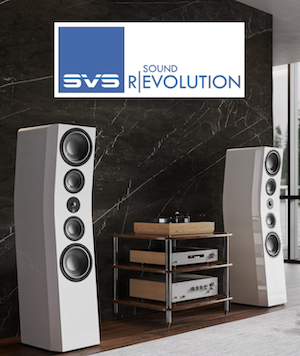- Manufacturer & Model
- SVS SoundPath Wireless Audio Adapter Kit
- MSRP
- $119.99 each
- Highlights
- SoundPath gives owners a wireless transmitter and receiver that can feed powered subwoofers, speakers, and AV equipment, compatible with nearly any brand of speaker or sub, connects using mini stereo plug, ships with a variety of connection cables.
- Summary
- The SVS SoundPath Wireless Audio Adapter Kit allows home theater fans to turn powered speakers, subs, and other AV equipment into wireless gear. It delivers a frequency range of 5Hz – 24kHz, which makes wireless subwoofer performance a reality. And it’s ability to transmit CD quality sound makes it a perfect mate for a powered stereo speaker. We found SoundPath to be a great replacement option for traditional cables and wire.
Here’s where SVS and its relatively new SoundPath Wireless Audio Adapter Kit ($119.99) enters the picture, giving audio fans the power to retro-fit wireless technology to commonly used non-wireless speakers and amps.
SoundPath is designed to play double duty, possessing the ability to transform nearly any powered subwoofer into a wireless performer, while also transmitting CD-quality sound between a source and powered speakers, a receiver, or an amplifier. The promise of such a device is huge for obvious reasons, but only truly huge if it works. So, I asked SVS to ship us a review sample for a closer inspection and real-world home theater testing, and what I found is quite impressive.
What’s in the Box
Before we talk performance, let’s take a look at what you get when you buy SoundPath. The kit ships in solid – no frills – packaging that gets the job done, internally protecting key components in a form-fitting plastic tray. Contents include a transmitter, a receiver, two USB power adapters, two 40” long USB to Micro USB power cords, two 17” long 3.5mm stereo male to stereo RCA male cables, two 15” long 3.5mm stereo to mono RCA male cables, and two 2” x 1”rectangles of 3M double sided tape. SVS also includes a miniaturized six page Owner’s Manual that offers placement tips, installation instructions, an FAQ, and troubleshooting steps (all of which can be found online).
SoundPath’s wireless transmitter and receiver modules are reasonably small (2.56” L x 1.88” W x .75” H) and extremely light (1.25 oz), which makes handling and placement a snap. Both are finished in a matte black coating that feels soft to the touch, and both look exactly alike minus a few labeling differences. Connectivity wise, each houses a 3.5mm mini-stereo jack and a Micro USB power input, while also presenting a blue LED indicator light and a small pairing button.
The included USB power adapters (1.56” L x 1.13” W x .75” H) are also black, but have a glossy sheen.
Installation
SVS scores big points for keeping SoundPath’s design intuitive, with a simple set up procedure that literally involves connecting power, inserting input and output audio cables, and waiting for an indicator light to signal when the factory-programmed wireless modules auto-pair. That means no complicated pairing procedures or fumbling with an app. And if the self-pairing process fails, both modules have reset buttons that re-initiate the process.
All being told, unboxing and installation takes roughly 10 minutes. And I didn't need to crack open the instruction booklet – it's pretty much plug and play. Using the kit’s cables (along with my own mini stereo to mini stereo cable), I was able to easily create wireless connections between a variety of equipment, including my laptop, an AV Receiver, a standalone amp, a powered speaker, and three different subwoofer models. Never once did I encounter pairing issues or confusing situations; this is a product that nearly anyone can install and operate with relatively little electronics knowledge.
My only nitpick takes aim at the included USB power adapters, which could use a redesign to help minimize protrusion from an outlet. As it stands, owners need to account for about 3.5” of clearance to accommodate a connected USB power cord and an adapter, which obviously is a non-issue for anyone sourcing power from a power strip. But, it might be an issue if your sub is positioned close to an existing wall outlet. It is worth noting, however, that you aren’t beholden to using the included adapters, as I was able to source power using USB ports found on a laptop, a powered speaker, and the backside of a receiver.
Testing and listening impressions
So, we know that SoundPath is nearly dummy proof when it comes to installation, but is it a one-to-one replacement for standard cables and wires? Can you rig SoundPath into an existing subwoofer system without compromising performance? Does it really transmit CD quality sound? Rather than detailing listening sessions and various testing scenarios, let’s take a look at what SoundPath claims to deliver and what I found during the review evaluation.
Claim #1: SoundPath’s signal is “ultra-low latency,” clocking at <25.5 milliseconds.
Reality: True. Latency or signal delay isn’t a concern if you’re using SoundPath to transmit a stereo signal to an amp or a pair of active speakers. But it could be problematic when asking it to feed a subwoofer or a rear speaker in a multi-channel system. Using a Denon X8500H AVR, I looked at Audyssey’s post-calibration subwoofer distance settings for two different 2.1 systems: one using a sub fed via cable versus one using SoundPath. The difference between the two was 28 feet, which equates to a delay of 25ms. Exactly as SVS claims.
While I couldn’t hear any lag in bass when using SoundPath in an uncalibrated system, I certainly confirmed that a 25ms delay exists. The good news is that SoundPath’s latency is fast enough that any receiver or processor with standard adjustments can compensate for the delay. That process can be automatically handled by a room calibration system, such as Audyssey, or manually adjusted within a receiver or processor’s distance settings menu. And because SoundPath’s latency is 25ms, owners simply need to add 28 feet to any subwoofer for proper compensation.
Claim #2: SoundPath provides “full-range wireless connectivity,” possessing the ability to transmit frequencies between 6Hz and 22kHz +/-1dB.
Reality: True. Using Room EQ Wizard, I was able to transmit and measure tones as low as 5Hz and up to 22kHz without issue. Additionally, listening tests didn’t reveal any holes or deficiencies in familiar demo material.
Claim #3: SoundPath has a working distance of “up to 65 feet” when the receiver and transmitter have line of sight.
Reality: True. I was able to get SoundPath to transmit a signal up to 69 feet when both the transmitter and receiver had an unimpeded line of sight. That measurement is at the outer limits of operability, though, with small movements causing signal drops. Indoors, I found performance distances to vary from room to room, but never experienced any dropouts at ranges measuring 20 feet or less. Within my own home theater room, I was able to get SoundPath to send a perfectly clean subwoofer signal, passing through a wall and furniture, at a distance of 18 feet. I can only surmise this means SoundPath will work without a hiccup in most in-home circumstances.
Claim #4: SoundPath sends a 16-bit/48kHz signal for CD quality sound.
Reality: True. Using a MacBook and an Emotiva XPA5 Amplifier, I was able to wirelessly play CD quality tracks without issue. As SVS claims, it was “pristine and accurate” (in other words: normal). I also used SoundPath to send audio to a RIVA Concert portable Wi-Fi speaker (connecting the receiver to the speaker’s mini-stereo input). As you can see in the informal measurements below, the speaker’s frequency response when wired (top) and wireless (bottom) was similar in nature.
Claim #5: SoundPath gives a subwoofer wireless freedom without sacrificing performance.
Reality: True. I integrated SoundPath into my home theater system, splitting the signal between two subwoofers, and noted zero performance issues, buzzing, or hum. Secondarily, I hooked up SoundPath to a single subwoofer for a quick informal frequency response measurement. As you can see, the wired (top) and wireless (bottom) response measurements practically mirrored each other, illustrating that SoundPath is a great direct replacement for a traditional subwoofer cable.
Conclusion
If you’re looking to rid a room of an unsightly subwoofer cable, then this is your lucky day. SVS’s SoundPath Wireless Audio Adapter Kit works and its relatively inexpensive cost is worth every penny. I was able to integrate the kit into a variety of setups without introducing performance hiccups or audio issues. For those of you facing the prospect of running a cable or wires across a room, or if you're looking for a tad more freedom when it comes to subwoofer placement, SoundPath is a great wireless alternative.
SoundPath Wireless Audio Adapter Specifications
Receiver
Operating Voltage: 5 VDC, 1A
RF Frequency Band: 2.404 - 2.476 GHz
Modulation: GFSK
Working Distance: up to 65 feet; line of sight
Transmitter Power: ≤ 10 dBm
Receiver Sensitivity: N/A
Frequency Response: 5Hz – 24 kHz +/- 1.5 dB
Delay Time: < 25.5 milliseconds
THD+N (dB): - 60 dB @ 1 kHz
SNR (db): + 85 dB @ 1 kHz
Transmitter
Operating Voltage: 5 VDC, 1A
RF Frequency Band: 2.404 - 2.476 GHz
Modulation: GFSK
Working Distance: up to 65 feet; line of sight
Transmitter Power: ≤ 10 dBm
Receiver Sensitivity: - 85 dBm
Frequency Response: 5Hz – 24 kHz +/- 1.5 dB
Delay Time: < 25.5 milliseconds
THD+N (dB): - 60 dB @ 1 kHz
SNR (db): + 85 dB @ 1 kHz
Last edited:









